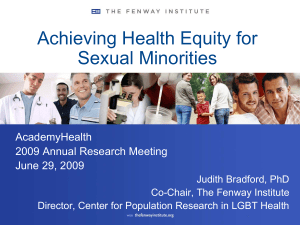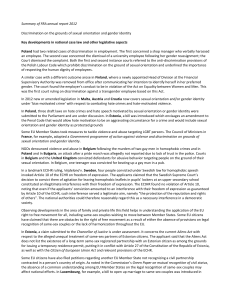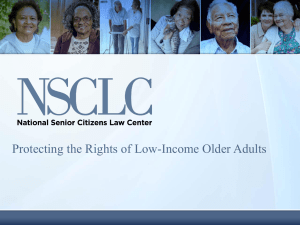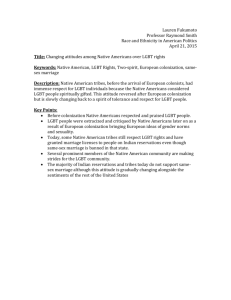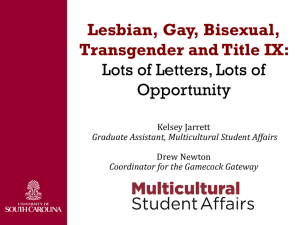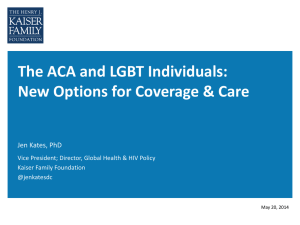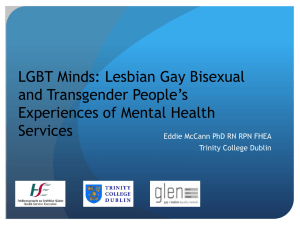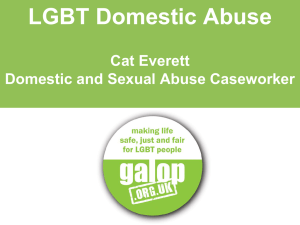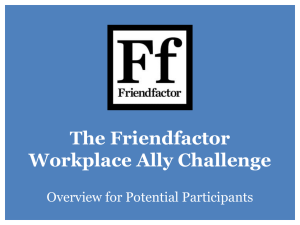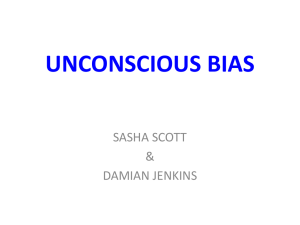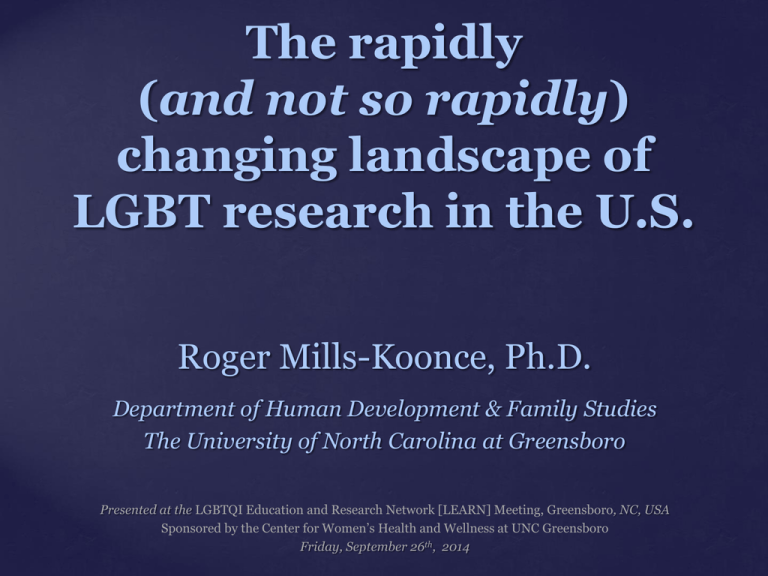
The rapidly
(and not so rapidly)
changing landscape of
LGBT research in the U.S.
Roger Mills-Koonce, Ph.D.
Department of Human Development & Family Studies
The University of North Carolina at Greensboro
Presented at the LGBTQI Education and Research Network [LEARN] Meeting, Greensboro, NC, USA
Sponsored by the Center for Women’s Health and Wellness at UNC Greensboro
Friday, September 26th, 2014
Outline
1.
Changes in the cultural and legal climate
2.
Changes in funding and research
What’s changed in 5 years?
Shifts in federal and state policies on same-sex marriage
June 26, 2013 - The U.S. Supreme Court rejects parts of the
Defense of Marriage Act (DOMA) and ruled that private
parties do not have "standing" to defend California's voterapproved ballot measure barring gay and lesbians couples
from state-sanctioned wedlock (Prop 8).
19 States with legal same-sex marriage
8 by Court Decision
8 by State Legislature
Massachusetts (May 17, 2004)
Connecticut (Nov. 12, 2008)
Iowa (Apr. 24, 2009)
California (June 28, 2013)
New Jersey (Oct. 21, 2013)
New Mexico (Dec. 19, 2013)
Oregon (May 19, 2014)
Pennsylvania (May 20, 2014)
Vermont (Sep. 1, 2009)
New Hampshire (Jan. 1, 2010)
New York (July 24, 2011)
Delaware (July 1, 2013)
Minnesota (Aug. 1, 2013)
Rhode Island (Aug. 1, 2013)
Hawaii (Dec. 2, 2013)
Illinois (June 1, 2014)
3 by Popular Vote
Maine (Dec. 29, 2012)
Maryland (Jan. 1, 2013)
Washington (Dec. 9, 2012)
31 States with same-sex marriage bans
25 by Constitutional Amendment and State Law
Alabama (2006, 1998), Alaska (1998, 1996), Arizona (2008, 1996), Arkansas
(2004, 1997), Colorado (2006, 2000), Florida (2008, 1997), Georgia (2004,
1996), Idaho (2006, 1996), Kansas (2005, 1996), Kentucky (2004, 1998),
Louisiana (2004, 1999), Michigan (2004, 1996), Mississippi (2004, 1997),
Missouri (2004, 1996), Montana (2004, 1997), North Carolina (2012, 1995),
North Dakota (2004, 1997), Ohio (2004, 2004), Oklahoma (2004, 1996), South
Carolina (2006, 1996), South Dakota (2006, 1996), Tennessee (2006, 1996),
Texas (2005, 1997), Utah (2004, 1997), Virginia (2006, 1997)
3 by Constitutional
Amendment Only
Nebraska (2000), Nevada (2002),
Wisconsin (2006)
3 by State Law Only
Indiana (1997), West Virginia
(2000), Wyoming (2003)
12 overturned bans now on appeal
25 by Constitutional Ammendment and State Law
Alabama (2006, 1998), Alaska (1998, 1996), Arizona (2008, 1996), Arkansas
(2004, 1997), Colorado (2006, 2000), Florida (2008, 1997), Georgia (2004,
1996), Idaho (2006, 1996), Kansas (2005, 1996), Kentucky (2004, 1998),
Louisiana (2004, 1999), Michigan (2004, 1996), Mississippi (2004, 1997),
Missouri (2004, 1996), Montana (2004, 1997), North Carolina (2012, 1995),
North Dakota (2004, 1997), Ohio (2004, 2004), Oklahoma (2004, 1996),
South Carolina (2006, 1996), South Dakota (2006, 1996), Tennessee (2006,
1996), Texas (2005, 1997), Utah (2004, 1997), Virginia (2006, 1997)
3 by Constitutional
Amendment Only
Nebraska (2000), Nevada (2002),
Wisconsin (2006)
3 by State Law Only
Indiana (1997), West Virginia
(2000), Wyoming (2003)
What’s changed in 5 years?
Shifts in the sociopolitical climate of the US in support for
same-sex marriage equality
However, these positive changes
are only part of the story…
Often policy change is followed by increases in private and local
homophobia and entrenchment of institutionalized heterosexism
According to the Institute of Medicine (2011), experiences with individual
and institutionalized homophobia/heterosexism (including experiences
within one’s family), increase LGBT individuals’ risks for:
Stress-induced psychopathology (i.e., depression, anxiety)
Non-suicidal self-injury and suicidal ideation and behavior
Physical health complications throughout the lifespan
Homelessness (especially among LGBT youth and young adults)
Bullying and victimization (among youth and adults)
There is still much work to be done in understanding these processes, the
unique risks and protective factors for LGBT individuals, and windows of
opportunity for education, prevention, and intervention
So… has social and behavioral
science research kept pace with
cultural change?
Peer-reviewed empirical research
1000
Empirical Publications on LGBT populations/topics
(Psyc Info)
900
800
700
600
500
400
300
200
100
0
2000
2001
2002
2003
2004
2006
2007
2008
2009
2010
2011
2012
2013
Working with limited funding…
Coulter, R.W. S . et al. (2014). Research Funded by the
National Institutes of Health on the Health of Lesbian, Gay,
Bisexual, and Transgender Populations. American Journal of
Public Health, 104(2), pp. 105-112.
Between 1989 and 2011, the NIH funded 628 studies
concerning LGBT health. This accounts for 0.5% of overall
funding during this time.
Of these studies, 79.1% focused on HIV/AIDS
Excluding projects about HIV/AIDS, only 0.1% (n = 113) of all
NIH-funded studies concerned LGBT health
But… in actual spending we are
talking about 0.5% of $45.6 billion
Administering Institute/Center
Projects Total Funding
National Institute of Allergy and Infectious Diseases
14
$69,696,558
National Cancer Institute
10
$16,214,057
National Institute on Drug Abuse
35
$10,837,731
National Institute of Child Health and Human Development
22
$7,629,507
National Institute of Mental Health
27
$8,486,517
National Institute on Alcohol Abuse and Alcoholism
6
$2,586,738
National Center for Chronic Disease Prevention and Health Promotion
5
$2,207,249
National Institute on Minority Health and Health Disparities
6
$1,940,958
National Institute on Aging
6
$1,371,422
National Institute of Diabetes and Digestive and Kidney Diseases
2
$664,100
National Institute of Nursing Research
2
$449,942
Fogarty International Center
2
$241,111
National Heart, Lung, and Blood Institute
1
$175,110
National Institute on Deafness and Other Communication Disorders
1
$144,875
National Institute on Neurological Disorders and Stroke
1
$31,370
140
$122,677,245
Total
But… most of these funds are going
to HIV/AIDS research
Administering Institute/Center
Projects Total Funding
National Institute of Allergy and Infectious Diseases
14
$69,696,558
National Cancer Institute
10
$16,214,057
National Institute on Drug Abuse
35
$10,837,731
National Institute of Child Health and Human Development
22
$7,629,507
National Institute of Mental Health
27
$8,486,517
National Institute on Alcohol Abuse and Alcoholism
6
$2,586,738
National Center for Chronic Disease Prevention and Health Promotion
5
$2,207,249
National Institute on Minority Health and Health Disparities
6
$1,940,958
National Institute on Aging
6
$1,371,422
National Institute of Diabetes and Digestive and Kidney Diseases
2
$664,100
National Institute of Nursing Research
2
$449,942
Fogarty International Center
2
$241,111
National Heart, Lung, and Blood Institute
1
$175,110
National Institute on Deafness and Other Communication Disorders
1
$144,875
National Institute on Neurological Disorders and Stroke
1
$31,370
140
$122,677,245
Total
A closer look at social science
research tells a different story…
Administering Institute/Center
Projects Total Funding
National Institute on Drug Abuse
35
$10,837,731
National Institute of Child Health and Human Development
22
$7,629,507
National Institute of Mental Health
27
$8,486,517
National Institute on Alcohol Abuse and Alcoholism
6
$2,586,738
National Institute on Minority Health and Health Disparities
6
$1,940,958
National Institute on Aging
6
$1,371,422
National Institute of Nursing Research
2
$449,942
104
$33,302,815
Total
A longitudinal view of funding for
these institutes
Since 1990 this reflects a yearly $750,000 increase in spending on LGBT
focused research by these institutes, although individual trajectories differ.
Is funding correlated with
productivity?
r = .672
Funding is in $100K units; Figure depicts funding 2 years prior to that year’s publications.
We’re likely getting more funding
because NIH has called for more
LGBT-oriented proposals…
But we’re also publishing more
because we care more about the
topic…
…
and we’re doing so on the cheap…
…
which is good and not-so-good.
Funding matters:
LGBT Research Challenges
Sexual orientation and gender nonconformity are
multifaceted concepts, and defining them operationally can be
challenging
Individuals may be reluctant to answer research questions
about their same-sex sexual behavior or gender
nonconformity.
Because LGBT populations represent a relatively small
proportion of the U.S. population, it is labor-intensive and
costly to recruit a large enough sample in general population
surveys for meaningful analysis of these populations and their
subgroups.
Moving forward
Increasing our focus on LGBT-specific topics of study and
aggressively pursuing support from both government and
private funding sources.
Reducing the heteronormativity of existing and future
research with population or community samples so that LGBT
individuals are not excluded or “invisible”
Reducing heteronormativity
and cis-genderism
Don’t assume that all participants are heterosexual, and don’t exclude
individuals who are not heterosexual
Triangulate sexual orientation by asking questions about identity,
behavior, and attraction
Ask about sex and gender separately and do not limit participants
response items
Sex
Female
Male
Male-to-female transsexual
Female-to-male transsexual
Intersex
Other (please specify)
Gender
Woman
Man
Androgyne
Transman
Transwoman
Genderqueer/gender non-conforming
Other (please specify)
Real example & real implications:
The American Community Survey
Yearly U.S. Census survey – a population sampling that
recognizes head-of-households in same-sex relationships
Does not ask about sexual orientation, only sex of individuals
in the household and marriage status
Because of a scoring problem, it is unclear what percentage of
same-sex couples reporting that they are legally married are
actually same-sex couples or miscoded opposite-sex couples
As a result, the ACS advises to only use data from nonmarried couples, reducing the same-sex sample by one-third
and completely under-representing this population.
Back to reducing
heteronormativity…
Having ONE question about sexual orientation would have
allowed us to untangle this mess and use most of the collected
data.
Not having that ONE question means that an entire subgroup
of the American population remains invisible on the ACS.
There are many implications… but one is that when the rest of
us are recruiting our samples, how do we know if we have a
representative sample of the LGBT population?
Summary
Our culture is changing and our laws are changing.
Federal funding and research efforts have increased over the
last 20 years, but have they increased enough?
Although not fast enough for many, these changes are moving
faster now than ever before, and there are clear implications for
the health and well-being of a large section of the U.S.
population
We need to push for funding in the social and behavioral
sciences
We need to make our research more inclusive- LGBT
individuals should be included as part of all studies, not only
LGBT-focused research
Thanks!


